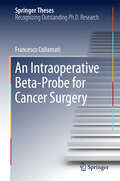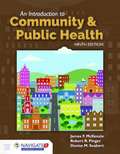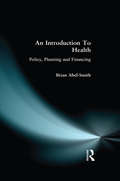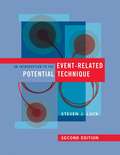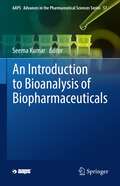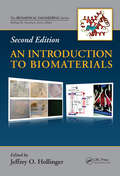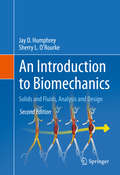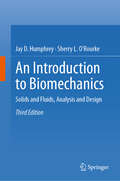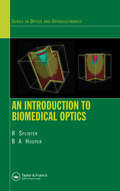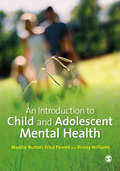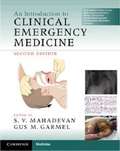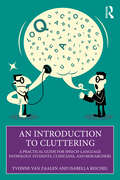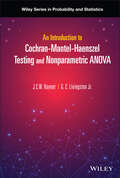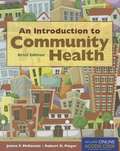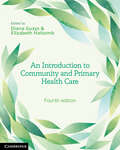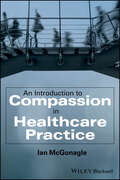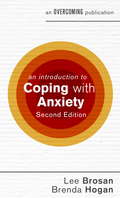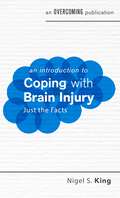- Table View
- List View
An Intraoperative Beta--Probe for Cancer Surgery (Springer Theses)
by Francesco CollamatiThis thesis focuses on a novel radio-guided surgery technique for complete tumor resections. It describes all aspects of the intraoperative probe, as well as testing and simulation of the novel technique. The presentation develops the technique from the initial idea to realistic feasibility studies that have been the subject of a press release of the American Society of Nuclear Medicine. Just a year after completing this work, the technique has now been tested for the first time on a meningioma patient, confirming all of the predictions made in this thesis.
An Introduction To Community And Public Health
by Robert R. Pinger Denise Seabert James F. McKenzieAn Introduction to Community & Public Health, Ninth Edition provides learners with the latest trends and statistics in this evolving field. With an emphasis on developing the knowledge and skills necessary for a career in health education and health promotion, this best-selling introductory text covers such topics as epidemiology, community organizations, program planning, minority health, mental health, environmental health, drug use and abuse, safety, and occupational health. A robust pedagogy and enhanced digital learning component encourages students to understand and retain community health issues and better prepare for their future careers.
An Introduction To Health: Policy, Planning and Financing
by Brian Abel-SmithThis book concerns itself with the key question: how to improve health in a cost effective and politically acceptable way. What makes people healthy? Why are the poor less healthy than the rich? Why do some countries have a better health record than others? An Introduction to Health is divided into four parts comprising the determinants of health, health service planning, health service financing, and controlling costs and securing user-friendly services.
An Introduction To The Event-related Potential Technique
by Steven J. LuckAn essential guide to designing, conducting, and analyzing event-related potential (ERP) experiments, completely updated for this edition. The event-related potential (ERP) technique, in which neural responses to specific events are extracted from the EEG, provides a powerful noninvasive tool for exploring the human brain. This volume describes practical methods for ERP research along with the underlying theoretical rationale. It offers researchers and students an essential guide to designing, conducting, and analyzing ERP experiments. This second edition has been completely updated, with additional material, new chapters, and more accessible explanations. Freely available supplementary material, including several online-only chapters, offer expanded or advanced treatment of selected topics. The first half of the book presents essential background information, describing the origins of ERPs, the nature of ERP components, and the design of ERP experiments. The second half of the book offers a detailed treatment of the main steps involved in conducting ERP experiments, covering such topics as recording the EEG, filtering the EEG and ERP waveforms, and quantifying amplitudes and latencies. Throughout, the emphasis is on rigorous experimental design and relatively simple analyses. New material in the second edition includes entire chapters devoted to components, artifacts, measuring amplitudes and latencies, and statistical analysis; updated coverage of recording technologies; concrete examples of experimental design; and many more figures. Online chapters cover such topics as overlap, localization, writing and reviewing ERP papers, and setting up and running an ERP lab.
An Introduction to Bioanalysis of Biopharmaceuticals (AAPS Advances in the Pharmaceutical Sciences Series #57)
by Seema KumarThe book provides a comprehensive review of the fundamental and practical aspects of bioanalytical support and the integral role it plays in the development of safe and efficacious biopharmaceutical drugs with speed and cost-effectiveness. The book focuses on a broad range of conventional and emerging biopharmaceutical modalities including monoclonal antibody-based therapeutics, gene therapy, cell therapy, peptides and oligonucleotides. The book starts with an introductory overview of bioanalysis showcasing the integral role it plays in understanding the drug disposition (pharmacokinetics/pharmacodynamics and immunogenicity) and the progression of bioanalytical strategy as the drug progresses through discovery and development stages of the program, taking into consideration the continually evolving regulatory landscape. The book further diversifies into individual biopharmaceutical modalities - monoclonal antibodies, antibody-drug conjugates, bispecifics, Fc-fusion proteins, gene therapies, cell therapies, peptides and oligonucleotides. The individual chapters focus on modality-specific bioanalytical assay strategies, critical reagents, assay formats, analytical platforms, associated bioanalytical challenges and mitigation strategies, industry best practices, and the latest understanding of regulatory guidance as applicable to the fast-growing biopharmaceutical landscape.
An Introduction to Biomaterials (Biomedical Engineering)
by Jeffrey O. HollingerA practical road map to the key families of biomaterials and their potential applications in clinical therapeutics, Introduction to Biomaterials, Second Edition follows the entire path of development from theory to lab to practical application. It highlights new biocompatibility issues, metrics, and statistics as well as new legislation for intelle
An Introduction to Biomechanics: Solids and Fluids, Analysis and Design
by Jay D. Humphrey Sherry L. O'RourkeThis book covers the fundamentals of biomechanics. Topics include bio solids, biofluids, stress, balance and equilibrium. Students are encouraged to contextualize principles and exercises within a "big picture" of biomechanics. This is an ideal book for undergraduate students with interests in biomedical engineering.
An Introduction to Biomechanics: Solids and Fluids, Analysis and Design
by Jay D. Humphrey Sherry L. O’RourkeThis textbook introduces the student to a consistent approach of formulating and solving problems involving the biomechanics of solids and fluids. Brief introductions are also provided for more complex situations that require methods of nonlinear elasticity, elastodynamics, viscoelasticity, or fluid-solid interactions. Concepts are motivated by concise descriptions of important biological, biomechanical, and clinical observations and techniques. Included are over 300 figures and 200 references, as well as complete derivations of the fundamental equations, solutions of over 100 example problems, and over 350 exercise problems. Perfect for a one- or two-semester introduction to biomechanics, this Third Edition includes expanded sections on complex fluid (non-Newtonian) and solid (nonlinear and anisotropic) behaviors as well as coupled problems for different tissues. Additional homework problems encourage the student to appreciate the broad applicability of the fundamental equations. An Introduction to Biomechanics, Third Edition is an ideal book for undergraduate students with interests in bioengineering, biomedical engineering, or biomechanical engineering, and serves as a valuable reference for graduate students, practicing engineers, and researchers. This book also: Guides students in developing intuitive understanding via a consistent consideration of diverse problems including cardiovascular, musculoskeletal, pulmonary, and cell mechanics Encourages students to develop a “big picture” approach to problem-solving in biomechanics through chapter summaries Challenges students to solve problems for conditions commonly experienced in the laboratory, industry, or the clinic
An Introduction to Biomedical Optics (Series in Optics and Optoelectronics)
by Robert Splinter Brett A. HooperMany universities now offer a course in biomedical optics, but lack a textbook specifically addressing the topic. Intended to fill this gap, An Introduction to Biomedical Optics is the first comprehensive, introductory text describing both diagnostic and therapeutic optical methods in medicine. It provides the fundamental background needed for grad
An Introduction to Brain and Behavior
by Bryan Kolb Ian Q. Whishaw G. Campbell TeskeyFrom authors Bryan Kolb and Ian Whishaw, and new coauthor G. Campbell Teskey, An Introduction to Brain and Behavior offers a unique inquiry-based introduction to behavioral neuroscience, with each chapter focusing on a central question (i. e. , "How Does the Nervous System Function?"). It also incorporates a distinctive clinical perspective, with examples showing students what happens when common neuronal processes malfunction. Now this acclaimed book returns in a thoroughly up-to-date new edition. Founders of a prestigious neuroscience institute at the University of Lethbridge in Alberta, Canada, Kolb and Whishaw are renowned as both active scientists and teachers. G. Campbell Teskey of the University of Calgary, also brings to the book a wealth of experience as a researcher and educator. Together, they are the ideal author team for guiding students from a basic understanding the biology of behavior to the very frontiers of some of the most exciting and impactful research being conducted today. The new edition also has its own dedicated version of Worth Publishers' breakthrough online course space, LaunchPad, giving it the most robust media component of any textbook for the course.
An Introduction to Catholic Ethics since Vatican II
by Andrew KimThis introduction provides a comprehensive overview of the development of Catholic ethics in the wake of the Second Vatican Council (1962–5), an event widely considered crucial to the reconciliation of the Catholic Church and the modern world. Andrew Kim investigates Catholic responses to questions of moral theology in all four principal areas: Catholic social teaching, natural law, virtue ethics, and bioethics. In addition to discussing contemporary controversies surrounding abortion, contraception, labor rights, exploitation of the poor, and just war theory, he explores the historical sources of the Catholic worldview. Beginning with the moral vision revealed through the person of Jesus Christ and continuing with elaborations on this vision from figures such as Augustine and Aquinas, this volume elucidates the continuity of the Catholic moral tradition. Its balance of complexity and accessibility makes it an ideal resource for both students of theology and general readers.
An Introduction to Child and Adolescent Mental Health
by Erica Pavord Briony Williams Maddie BurtonAnyone who works within children and adolescent mental health services will tell you what a challenging and complex world it is. To help prepare you, the authors have produced a clear introduction to child and adolescent mental health that takes you step-by-step on a journey through the subject. Beginning with the foundations, the book explores the common mental health concepts and influences that you can expect to encounter examining topics like the difference between emotional and mental health issues and how mental health problems develop. It then moves on to explore the vital skills that you will need to develop like effective communication and basic counselling skills, and introduces some of the common interventions like Cognitive Behavioural Therapy, Psychodynamic theory and Family work. Written by a multi-disciplinary team of passionate and experienced experts, the book strikes an effective balance between introducing the relevant theory and showing how this can be applied in the real world. It is an essential starting point to the subject of child and adolescent mental health and suitable for any students planning to support this group.
An Introduction to Clinical Emergency Medicine
by Gus M. Garmel S. V. MahadevanBuilding on the strengths of its award-winning predecessor, this new edition of An Introduction to Clinical Emergency Medicine is a must-have resource for individuals training and practising in this challenging specialty. Guided by the patient's chief complaint, this text presents a concise, methodical approach to patient evaluation, management and problem solving in the Emergency Department. Unlike other textbooks, which elaborate on known diagnoses, this extraordinary book approaches clinical problems as clinicians approach patients - without full knowledge of the final diagnosis. Fully revised and updated, the second edition includes new chapters on sepsis, bleeding, burns, neonatal, alcohol-related, and dental emergencies. Stunning full-color chapters include clinical images (photographs, ECGs and radiologic studies), detailed illustrations and practical tables. Written and edited by experienced educators, researchers, and practitioners in Emergency Medicine, this text is core reading for students and residents, and an important resource for practising emergency physicians, faculty, and other healthcare providers.
An Introduction to Clinical Emergency Medicine
by Gus M. Garmel S. V. MahadevanBuilding on the strengths of its award-winning predecessor, this new edition of An Introduction to Clinical Emergency Medicine is a must-have resource for individuals training and practising in this challenging specialty. Guided by the patient's chief complaint, this text presents a concise, methodical approach to patient evaluation, management and problem solving in the Emergency Department. Unlike other textbooks, which elaborate on known diagnoses, this extraordinary book approaches clinical problems as clinicians approach patients - without full knowledge of the final diagnosis. Fully revised and updated, the second edition includes new chapters on sepsis, bleeding, burns, neonatal, alcohol-related, and dental emergencies. Stunning full-color chapters include clinical images (photographs, ECGs and radiologic studies), detailed illustrations and practical tables. Written and edited by experienced educators, researchers, and practitioners in Emergency Medicine, this text is core reading for students and residents, and an important resource for practising emergency physicians, faculty, and other healthcare providers.
An Introduction to Cluttering: A Practical Guide for Speech-Language Pathology Students, Clinicians, and Researchers
by Yvonne van Zaalen Isabella ReichelAn Introduction to Cluttering explores the speech disorder of cluttering, offering concrete, evidence-based methods for its diagnosis and treatment.Cluttering is a globally recognized communication disorder, yet it is often poorly understood. This book presents a historical overview of the efforts of pioneers in the field to demystify the cluttering disorder, before introducing the aetiology and symptoms of cluttering from several perspectives: physiological, psycho-linguistic, neurological, social, affective, and cognitive. It also provides an in-depth discussion of the identification, differential diagnosis, and assessment of cluttering, using current and advanced diagnostic procedures before explaining the rationales and unique, innovative procedures for evidence-based treatments of cluttering. Engaging practical examples and theory boxes are featured throughout the book.Providing effective and user-friendly procedures for cluttering diagnosis and intervention, this book is an essential read for all current and future speech and language therapists.
An Introduction to Cochran-Mantel-Haenszel Testing and Nonparametric ANOVA (Wiley Series in Probability and Statistics)
by J. C. Rayner G. C. Livingston Jr.An Introduction to Cochran-Mantel-Haenszel Testing and Nonparametric ANOVA Complete reference for applied statisticians and data analysts that uniquely covers the new statistical methodologies that enable deeper data analysis An Introduction to Cochran-Mantel-Haenszel Testing and Nonparametric ANOVA provides readers with powerful new statistical methodologies that enable deeper data analysis. The book offers applied statisticians an introduction to the latest topics in nonparametrics. The worked examples with supporting R code provide analysts the tools they need to apply these methods to their own problems. Co-authored by an internationally recognised expert in the field and an early career researcher with broad skills including data analysis and R programming, the book discusses key topics such as: NP ANOVA methodology Cochran-Mantel-Haenszel (CMH) methodology and design Latin squares and balanced incomplete block designs Parametric ANOVA F tests for continuous data Nonparametric rank tests (the Kruskal-Wallis and Friedman tests) CMH MS tests for the nonparametric analysis of categorical response data Applied statisticians and data analysts, as well as students and professors in data analysis, can use this book to gain a complete understanding of the modern statistical methodologies that are allowing for deeper data analysis.
An Introduction to Community Health (Brief Edition)
by James F. Mckenzie Robert R. PingerAn Introduction to Community Health Brief Edition is a condensed and fully updated version of the bestselling classic health text. It is ideally suited for students in Health Education, Nursing, and Social Work programs. Like the full-length text, the condensed edition provides comprehensive coverage of epidemiology, adolescent and child health, health and safety in the workplace, environmental health, and minority and elder health. This is the only condensed community health text on the market and is suitable for institutions with shorter academic terms. Key pedagogical features such as chapter objectives, review questions, key terms, and a full glossary can also be found within the brief edition.
An Introduction to Community and Primary Health Care
by Diana Guzys Rhonda Brown Elizabeth Halcomb Dean WhiteheadCommunity nursing is the fastest growing area of nursing practice in Australia. This book offers an engaging introduction to the theory, skills and application of community and primary health care. Based on the 'Social Model of Health', An Introduction to Community and Primary Health Care explores how social and environmental factors impact healthcare in Australian communities. It discusses the principles of health and mental health promotion, the importance of cultural competence and the practice of community needs assessment. The book is divided into three parts - theory, skills and health professionals in practice. This latter section is unique to this book and encourages students to consider how various nursing roles address issues of social justice, equality and access. Readable and highly practical, An Introduction to Community and Primary Health Care equips students with the theory, skills and understanding they will need as community and primary healthcare professionals working across Australia.
An Introduction to Community and Primary Health Care
by Diana Guzys Eileen PetrieCommunity nursing is the fastest growing area of nursing practice in Australia. This book offers an engaging introduction to the theory, skills and application of community and primary health care. Based on the 'Social Model of Health', An Introduction to Community and Primary Health Care in Australia explores how social and environmental factors impact healthcare in Australian communities. It discusses the principles of health and mental health promotion, the importance of cultural competence and the practice of community needs assessment. The book is divided into three parts - theory, skills and health professionals in practice. This section is unique to this book and encourages students to consider how various nursing roles address issues of social justice, equality and access. Readable and highly practical, An Introduction to Community and Primary Health Care in Australia equips students with the theory, skills and understanding they will need as community and primary healthcare professionals working across Australia.
An Introduction to Community and Primary Health Care
by Diana Guzys Elizabeth HalcombAn Introduction to Community and Primary Health Care provides a comprehensive and practical explanation of the fundamentals of the social model of health care approach, preparing learners for professional practice in Australia and Aotearoa New Zealand. The fourth edition has been restructured into four parts covering theory, key skills for practice, working with diverse communities and the professional roles that nurses can enter as they transition to primary care and community health practice. Each chapter has been thoroughly revised to reflect the latest research and includes up-to-date case studies, reflection questions and critical thinking activities to strengthen students' knowledge and analytical skills. Written by an expert team of nurse authors with experience across a broad spectrum of professional roles, An Introduction to Community and Primary Health Care remains an indispensable resource for nursing students and health professionals engaging in community and primary health care.
An Introduction to Compassion in Healthcare Practice
by Ian McGonagleExplore the concept of compassion as it applies to the field of healthcare and improving patient outcomes An Introduction to Compassion in Healthcare Practice identifies the core components of being compassionate and self-compassionate, so that we may be in a better position to attend to our health and to engage in helping others. The foundation of this book is that if we have an intention to help, we are best served by understanding what ‘helping’ really means. This is addressed by reviewing compassion in a range of contexts and environments, including through an evolutionary science perspective. In this view, we are ‘programmed’ to be compassionate—but social forces may throw challenges or obstacles in our way. Also covered in this text are the challenges associated with being compassionate to the self, as well as care encounters with individuals in a clinical context and working in a clinical team. Some of the ideas explored in An Introduction to Compassion in Healthcare Practice include: Artificial intelligence (AI) and compassion, covering ethical theories for AI alongside considerations surrounding consent and the role of touch The role of mindfulness in self-compassion, the challenges and benefits of self-compassion, perfectionism, our “inner critic”, and shame Complex Adaptive Systems (CAS) in teamwork, lessons in developing compassionate teams, and the theory of Values-Based Practice Components of compassion-focused leadership and supervision, and the development of self-efficacy and competence Providing a core conceptual framework for compassion in healthcare with guidance on how to explore various topics in greater depth, An Introduction to Compassion in Healthcare Practice is an essential reference for undergraduate nurses, midwives, allied health professionals, medical practitioners, and students in related programs of study.
An Introduction to Continuous-Time Stochastic Processes: Theory, Models, and Applications to Finance, Biology, and Medicine (Modeling and Simulation in Science, Engineering and Technology)
by Vincenzo Capasso David BaksteinThis textbook, now in its third edition, offers a rigorous and self-contained introduction to the theory of continuous-time stochastic processes, stochastic integrals, and stochastic differential equations. Expertly balancing theory and applications, the work features concrete examples of modeling real-world problems from biology, medicine, industrial applications, finance, and insurance using stochastic methods. No previous knowledge of stochastic processes is required. Key topics include:Markov processesStochastic differential equationsArbitrage-free markets and financial derivativesInsurance riskPopulation dynamics, and epidemicsAgent-based modelsNew to the Third Edition:Infinitely divisible distributionsRandom measuresLevy processesFractional Brownian motionErgodic theoryKarhunen-Loeve expansionAdditional applicationsAdditional exercisesSmoluchowski approximation of Langevin systemsAn Introduction to Continuous-Time Stochastic Processes, Third Edition will be of interest to a broad audience of students, pure and applied mathematicians, and researchers and practitioners in mathematical finance, biomathematics, biotechnology, and engineering. Suitable as a textbook for graduate or undergraduate courses, as well as European Masters courses (according to the two-year-long second cycle of the "Bologna Scheme"), the work may also be used for self-study or as a reference. Prerequisites include knowledge of calculus and some analysis; exposure to probability would be helpful but not required since the necessary fundamentals of measure and integration are provided. From reviews of previous editions:"The book is . . . an account of fundamental concepts as they appear in relevant modern applications and literature. . . . The book addresses three main groups: first, mathematicians working in a different field; second, other scientists and professionals from a business or academic background; third, graduate or advanced undergraduate students of a quantitative subject related to stochastic theory and/or applications. " -Zentralblatt MATH
An Introduction to Coping with Anxiety, 2nd Edition (An Introduction to Coping series)
by Brenda Hogan Leonora BrosanOvercoming app now available via iTunes and the Google Play Store.Anxiety is one of the most common mental health conditions worldwide, affecting millions of people each year. But it can be treated effectively with cognitive behavioural therapy (CBT).Written by experienced practitioners, this introductory book can help you if anxiety has become a problem. It explains what anxiety is and how it makes you feel when it becomes unmanageable or lasts for long periods of time. It will help you to understand your symptoms and is ideal as an immediate coping strategy and as a preliminary to fuller therapy. You will learn:· What anxiety is and how it develops· Physical symptoms to look out for· How to spot and challenge thoughts that make you anxious· Ways to change how you behave in order to reduce your feelings of anxiety
An Introduction to Coping with Brain Injury (An Introduction to Coping series)
by Nigel S. KingJust the facts for coping with the after-effects of a brain injuryAcquired Brain Injury (ABI) usually refers to people who have suffered a head injury or stroke but also includes those who have had brain tumours, an anoxic injury (where the brain has been starved of oxygen) or brain illnesses like encephalitis and meningitis. After an ABI, the brain undergoes a very slow healing process before improvements slow down and eventually plateau. This is different to other forms of brain conditions where the journey is more of a deteriorating one over time.ABI is commonly called 'a hidden disability' as it can easily be missed or misunderstood by others. Also it can significantly affect those close to the person and therefore it is frequently called 'a family affair' too. As the issues are often hidden, complicated and affect patients and families alike, this book can act as a roadmap to help you and your loved ones navigate through the complex and often unexpected challenges that can arise following a brain injury, using:- Cognitive rehabilitation approaches to understand and manage changes in our thinking abilities- Cognitive behavioural approaches to address ways in which our thoughts, feelings, actions and physical reactions relate to each other
An Introduction to Coping with Brain Injury (An Introduction to Coping series)
by Nigel S. KingJust the facts for coping with the after-effects of a brain injuryAcquired Brain Injury (ABI) usually refers to people who have suffered a head injury or stroke but also includes those who have had brain tumours, an anoxic injury (where the brain has been starved of oxygen) or brain illnesses like encephalitis and meningitis. After an ABI, the brain undergoes a very slow healing process before improvements slow down and eventually plateau. This is different to other forms of brain conditions where the journey is more of a deteriorating one over time.ABI is commonly called 'a hidden disability' as it can easily be missed or misunderstood by others. Also it can significantly affect those close to the person and therefore it is frequently called 'a family affair' too. As the issues are often hidden, complicated and affect patients and families alike, this book can act as a roadmap to help you and your loved ones navigate through the complex and often unexpected challenges that can arise following a brain injury, using:- Cognitive rehabilitation approaches to understand and manage changes in our thinking abilities- Cognitive behavioural approaches to address ways in which our thoughts, feelings, actions and physical reactions relate to each other
